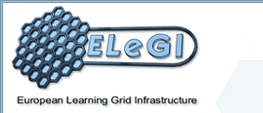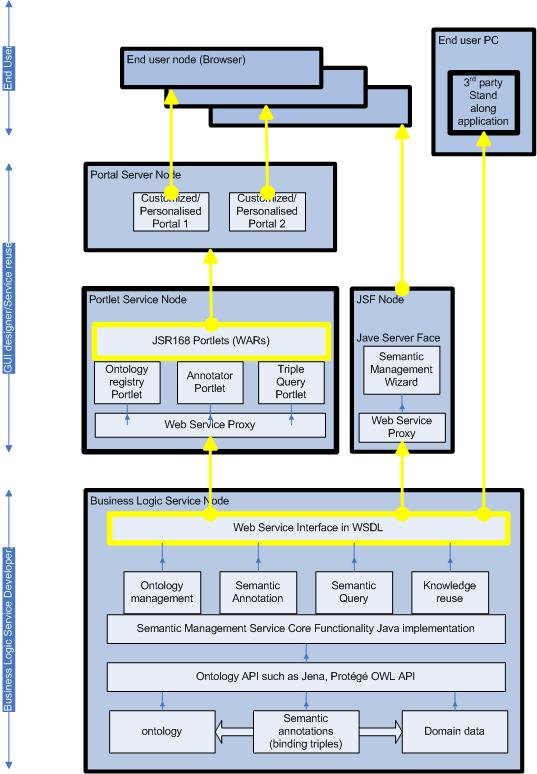

ELeGI at UoSAt Southampton we are interested in how the semantic web and knowledge technology can be used in the project to enhance learning experience and manage learning resources at a semantic layer. We aim to provide Ontology Support, Semantic Management Services, and Semantic Knowledge Services to help other project partners manage ontology, carry out semantic enrichment and query semantically enriched learning resources. The development is in line with the following key steps as defined in the Semantic Web based Knowledge Life Cycle.
Ontology Support - UoS investigates potential learning domains that can benefit from the semantic layer. We then work on available resources in that domain and provide formal domain conceptualization in the form of ontology. This ontology is then used in the following steps as shared understanding and constraints. The ontology reduces the ambiguity of the knowledge modeling by explicitly declaring vocabulary and their semantics. SEES (Service Elicitation and Exploitation Scenarios) - It aims to develop and gain insight into the process involved from formulating pedagogic requirements to the implementing environments that meet these requirements. A set of test bed has been investigated in both formal and informal learning in accordance to the SEES. SEES provides domains that can potentially require the ontology support to an added semantic layer.
This is accomplished through semantic annotation on resources (content and services). Knowledge instances in this case mean explicit statements using the vocabulary and semantics pre-defined in the Ontology. UoS provides a set of Semantic Management Services (SMS) that can be deployed in different domains (driven by domain ontology) to facilitate this purpose.
This mainly allows reuse of the semantic annotations acquired in the previous step. the reuse can be categorized as simple query and more complex and powerful semantic inference/reasoning. The Semantic Knowledge Services are advanced domain related knowledge reuse based on simple query and inference.
Service Oriented Architecture - SOAThe architecture of ELeGI Semantics management adopts SOA with an aim to improve extendability and interpretability. The SOA enables distributed computation and collaboration over the web through a loosely coupled system with the benefit of increased flexibility and faster development cycle. Service providers publish focused functionalities as web services into public service registry and consumers reuse them as web component to build distributed domain applications to accomplish more complex tasks. To accommodate the SOA philosophy, we have proposed the following technical architecture where the semantics management services sit in the business logic layer driven by the domain ontology.
To support users at different levels, we also provide a higher level Potlet layer that couple with the semantic management services and provides GUI service conforming to the JSR168 portlet specification.
Current UoS tasks and involvements in ElegiWP8 - This is the work package to implement design and specifications made in WP7. UoS is currently providing ontology and deploying semantic management services as web services. We are also identifying domains in the SEES for further integration and development of the semantic layer in the project. (D59) WP7 - D50 and D38 are the main delivery where we provide the design and specification of the ontology and semantic management services.
Elegi project descriptionELeGI is a large (23 partners) EU project which has the aim of developing a European Learning Grid Infrastructure. The European Learning Grid Infrastructure (ELeGI) project has the ambitious goal to develop software technologies for effective human learning. With the ELeGI project we will promote and support a learning paradigm shift. A new paradigm focused on knowledge construction using experiential based and collaborative learning approaches in a contextualised, personalised and ubiquitous way will replace the current information transfer paradigm focused on content and on the key authoritative figure of the teacher who provides information. We have chosen a synergic approach, sometimes called “human centred design”, to replace the classical, applicative approach to learning. With consideration of humans at the centre, learning is clearly a social, constructive phenomenon. It occurs as a side effect of interactions, conversations and enhanced presence in dynamic Virtual Communities: experimental research concepts integrating new powerful developments of services in the Semantic GRID, the leading edge of currently available and future ICT technologies, with highly innovative and powerfully significant scenarios of human learning. The ELeGI project has three main goals: Goal 1. To define new models of human learning enabling ubiquitous and collaborative learning, merging experiential, personalised and contextualised approaches. Goal 2. To define and implement an advanced service-oriented Grid based software architecture for learning. This will allow us to access and integrate different technologies, resources and contents that are needed in order to realise the new paradigm. This objective will be driven by the pedagogical needs and by the requirements provided by the test-beds (SEES) and informed by the experience gained through implementing the demonstrators. Goal 3. To validate and evaluate the software architecture and the didactical approaches through the use of SEES and demonstrators. The project will build extensively on advanced work already done, creating new learning environments rather than creating new learning resources per se.
|
